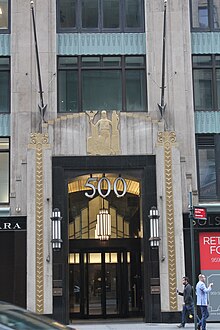
42nd Street is a major crosstown street in the New York City borough of Manhattan, spanning the entire breadth of Midtown Manhattan, from Turtle Bay at the East River, to Hell's Kitchen at the Hudson River on the West Side. The street has several major landmarks, including the headquarters of the United Nations, the Chrysler Building, Grand Central Terminal, the New York Public Library Main Branch, Times Square, and the Port Authority Bus Terminal.

The Fuller Building is a skyscraper at 57th Street and Madison Avenue in the Midtown Manhattan neighborhood of New York City. Designed by Walker & Gillette, it was erected between 1928 and 1929. The building is named for its original main occupant, the Fuller Construction Company, which moved from the Flatiron Building.

The Fred F. French Building is a skyscraper at 551 Fifth Avenue on the northeast corner with 45th Street in Midtown Manhattan, New York City. Designed by H. Douglas Ives along with John Sloan and T. Markoe Robertson of the firm Sloan & Robertson, it was erected in 1927. The building is named for Fred F. French, owner of the Fred F. French Companies, for whom the structure was commissioned.

The Chanin Building, also known as 122 East 42nd Street, is a 56-story office skyscraper in Midtown Manhattan in New York City. It is on the southwest corner of 42nd Street and Lexington Avenue, near Grand Central Terminal to the north and adjacent to 110 East 42nd Street to the west. The building is named for Irwin S. Chanin, its developer.
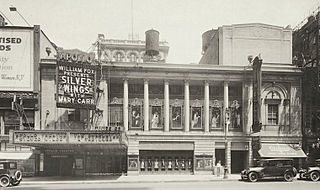
The Times Square Theater is a former Broadway and movie theater at 215–217 West 42nd Street in the Theater District of Midtown Manhattan in New York City, near Times Square. Built in 1920, it was designed by Eugene De Rosa and developed by brothers Edgar and Archibald Selwyn. The building, which is no longer an active theater, is owned by the city and state governments of New York and leased to New 42nd Street.

The Daily News Building, also known as The News Building, is a skyscraper at 220 East 42nd Street in the East Midtown neighborhood of Manhattan in New York City, United States. The original tower was designed by architects Raymond Hood and John Mead Howells in the Art Deco style, and it was erected between 1928 and 1930. A later addition was designed by Harrison & Abramovitz and built between 1957 and 1960.
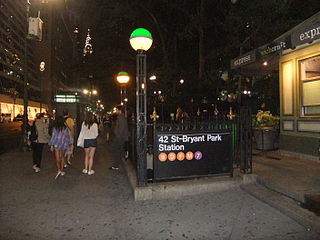
The 42nd Street–Bryant Park/Fifth Avenue station is an underground New York City Subway station complex, consisting of stations on the IRT Flushing Line and IND Sixth Avenue Line. Located at 42nd Street between Fifth Avenue and Sixth Avenue in Manhattan, it is served by the 7, D and F trains at all times, the B and M trains on weekdays, and the <7> and <F> trains during rush hours in the peak direction. A free passageway from the IND platforms to the Times Square–42nd Street/Port Authority Bus Terminal station, served by the 1, 2, 3, 7, <7>, A, C, E, N, Q, R, W, and S trains is open during the day from 6 a.m. to 12 a.m. Only the Times Square transfers are announced on NTT trains.

660 Fifth Avenue is a 41-story office building on the west side of Fifth Avenue between 52nd and 53rd Streets in the Midtown Manhattan neighborhood of New York City. The office tower was designed by Carson & Lundin and built for its developer Tishman Realty and Construction from 1955 to 1957.

330 West 42nd Street, also known as the McGraw-Hill Building and formerly the GHI Building, is a 485-foot-tall (148 m), 33-story skyscraper in the Hell's Kitchen neighborhood of Manhattan in New York City, United States. Designed by Raymond Hood and J. André Fouilhoux in a mixture of the International Style, Art Deco, and Art Moderne styles, the building was constructed from 1930 to 1931 and originally served as the headquarters of the McGraw-Hill Companies.
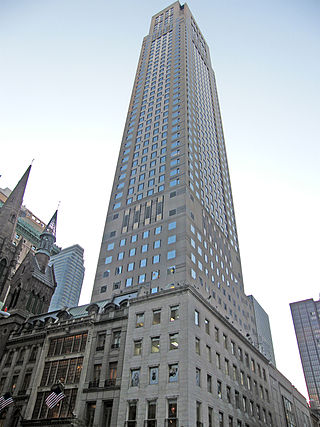
712 Fifth Avenue is a 650-foot-tall (200 m) skyscraper at 56th Street and Fifth Avenue in the Midtown Manhattan neighborhood of New York City. Constructed from 1987 to 1990, it was designed by SLCE Architects and Kohn Pedersen Fox Associates. The skyscraper's base includes the Coty Building at 714 Fifth Avenue and the Rizzoli Bookstore building at 712 Fifth Avenue, both of which are New York City designated landmarks.

The Candler Building is a skyscraper at the southern end of Times Square in the Midtown Manhattan neighborhood of New York City. Located at 220 West 42nd Street, with a secondary address of 221 West 41st Street, the 24-story building was designed by the firm of Willauer, Shape and Bready in the Spanish Renaissance style. It was constructed between 1912 and 1913 for Coca-Cola Company owner Asa Griggs Candler. The Candler Building was one of the last skyscrapers built in New York City before the 1916 Zoning Resolution, which required setbacks. It is listed on the National Register of Historic Places (NRHP).

The Salmon Tower Building is a 31-story skyscraper located at 11 West 42nd Street and 20 West 43rd Street in Manhattan, New York City, near Bryant Park. It was designed by Albert J. Wilcox and finished in 1928. It was developed by a firm headed by Walter J. Salmon Sr. Directly to the west of the Salmon Tower Building is the former Aeolian Building, and to its east is 500 Fifth Avenue, also built by Salmon Sr.

The Manufacturers Trust Company Building, also known as 510 Fifth Avenue, is a commercial building at the southwest corner of West 43rd Street and Fifth Avenue in Midtown Manhattan, New York City. Opened in 1954, it is the first bank building in the United States to be built in the International Style. Charles Evans Hughes III and Gordon Bunshaft of Skidmore, Owings & Merrill (SOM) designed the building, along with Roy O. Allen and project manager Patricia W. Swan. The interior was designed by Eleanor H. Le Maire, while Harry Bertoia was hired as an artist for some of the building's artwork. 510 Fifth Avenue was built as a bank for the Manufacturers Trust Company, whose president Horace C. Flanigan wanted the design to be inviting to customers.
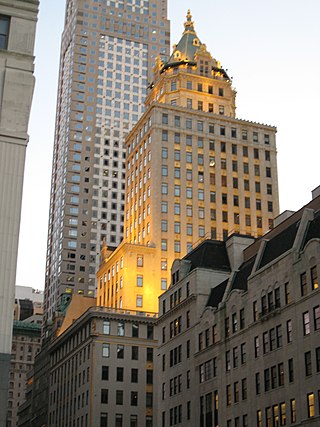
The Crown Building is a 25-story, 416-foot-tall (127 m) building at 730 Fifth Avenue, on the southwest corner of Fifth Avenue and 57th Street, in the Midtown Manhattan neighborhood of New York City. Constructed between 1920 and 1922 for the philanthropist August Heckscher, the structure was designed by Warren and Wetmore as an office building. The lower levels contain retail space, while the upper levels became the luxury Aman New York hotel and residences in 2022. The structure has been a New York City designated landmark since 2024.
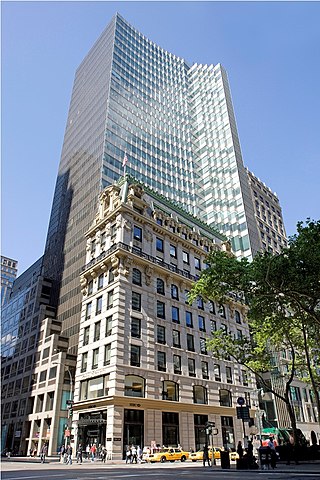
452 Fifth Avenue is an office building at the southwest corner of Fifth Avenue and 40th Street in the Midtown Manhattan neighborhood of New York City. The building primarily consists of the 30-story, 400-foot (120 m) HSBC Tower, completed in late 1985 and designed by Attia & Perkins. The 10-story Knox Building, a Beaux-Arts office building designed in 1902 by John H. Duncan, is preserved at the base of the skyscraper. 452 Fifth Avenue faces Bryant Park immediately to the north.

The Coty Building is a building at 714 Fifth Avenue in the Midtown Manhattan neighborhood of New York City. The six-story building contains a French-inspired facade and mansard roof, which are integrated into the base of the adjoining skyscraper at 712 Fifth Avenue. The third through fifth floors contain 276 decorative glass panes, the only documented architectural work by René Lalique in the United States.
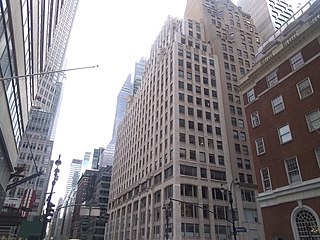
400 Madison Avenue is a 22-story office building in Midtown Manhattan in New York City. It is along Madison Avenue's western sidewalk between 47th and 48th Streets, near Grand Central Terminal. 400 Madison Avenue was designed by H. Craig Severance with Neo-Gothic architectural detailing.

10 West 56th Street is a commercial building in the Midtown Manhattan neighborhood of New York City. It is along 56th Street's southern sidewalk between Fifth Avenue and Sixth Avenue. The six-story building was designed by Warren and Wetmore in the French Renaissance Revival style. It was constructed in 1901 as a private residence, one of several on 56th Street's "Bankers' Row".

275 Madison Avenue is a 43-story office building in the Murray Hill neighborhood of Manhattan in New York City. It is along the southeast corner of Madison Avenue and 40th Street, near Grand Central Terminal. The building, constructed from 1930 to 1931, was designed by Kenneth Franzheim in a mixture of the Art Deco and International styles.

The Sofia is a condominium building at the corner of Columbus Avenue and 61st Street on the Upper West Side of Manhattan in New York City. It was constructed from 1929 to 1930 and was designed by the firm of Jardine, Hill & Murdock in the Art Deco style for Kent Automatic Garages. The Sofia is 27 stories tall; the first nine stories above the ground level are used as offices, while the top 17 stories contain residential condominiums. The building is a New York City designated landmark and on the National Register of Historic Places.




